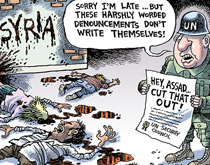A bunch of serious-looking men are on TV. The 13-year-old boy sighs. The Brady Bunch is on right now, but his dad, a pulmonary physician, insists on watching the Watergate hearings. The youngster wishes he could wander off, maybe doodle some comics.

In 1977, five years after the televised hearings, Rob Rogers, who still loves to draw, begins college. He checks with the editor of the school newspaper to see if he can contribute as an illustrator. Turns out, the paper could use an editorial cartoonist. He remembers how his dad, a “political junkie,” tried interesting him in politics. With that in mind, he creates a cartoon about a campus controversy: Should bright lights be installed around a romantic campus hideaway where, sadly, some crimes have been committed? Rogers’ cartoon depicts ominous eyes that turn out to be ducks when well lit. It lands on the front page. Letters flood in, both admonishing and praising the cartoon’s “message.” Rogers realizes that his work can have a political voice.

He continues honing that voice while earning his MFA in art at Carnegie Mellon, working as an editorial cartoonist for a variety of publications. Unlike most of his classmates who follow traditional paths in the fine arts, after graduating in 1984, he puts to use his skills of visual portrayal developed at CMU—not on canvas, but on newsprint—as the editorial cartoonist for Pittsburgh’s largest daily newspaper, the Pittsburgh Press. Today, he has the same job at what is now the Pittsburgh Post-Gazette, and his work is also nationally syndicated.
Recently, he received The Thomas Nast Award from the Overseas Press Club of America for excellence in cartooning on international affairs. Along with the Pulitzer Prize and a handful of other awards, it’s one of the most coveted honors for editorial cartoonists.
—Olivia London (DC’13)



